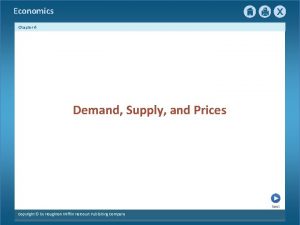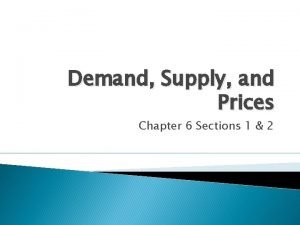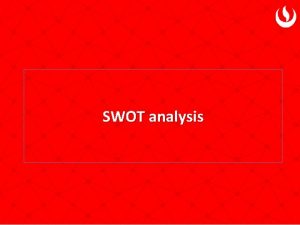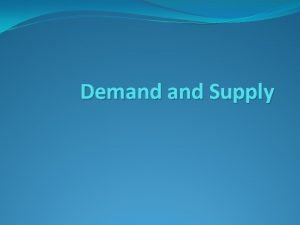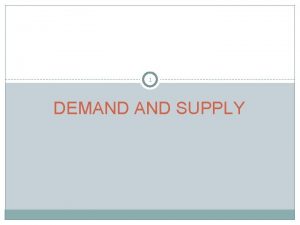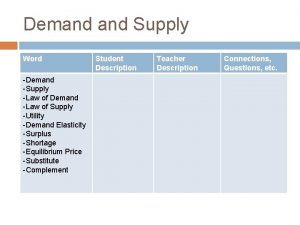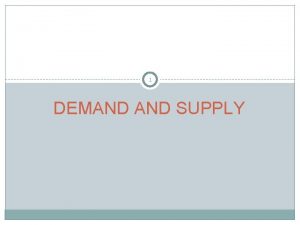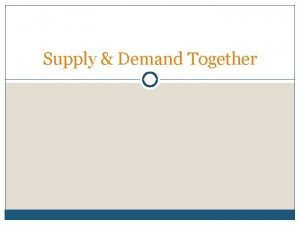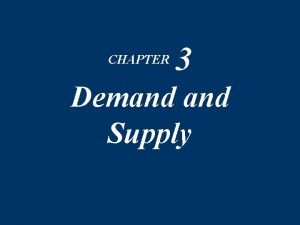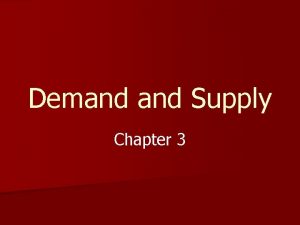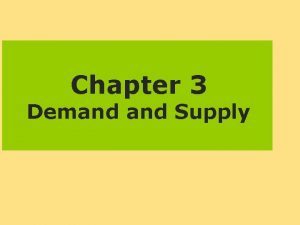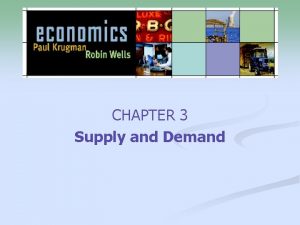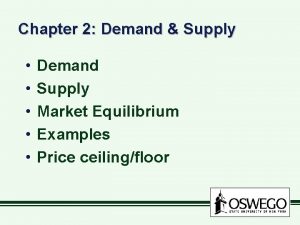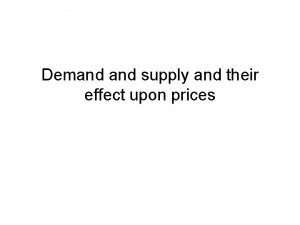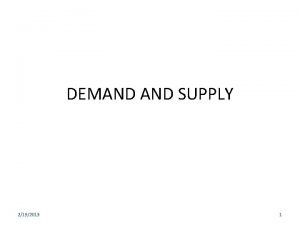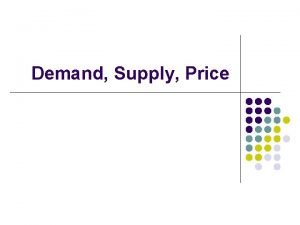Chapter 35 Demand Supply Learning Outcomes Upon completion
























- Slides: 24


Chapter 35

Demand Supply

Learning Outcomes Upon completion of this chapter you should be able to: • Explain what a market is and illustrate examples of markets commonly found in Ireland • Explain what is meant by ‘demand’ and ‘supply’ • Outline the relationship between the level of demand for a good or service and its price and list factors other than price, which impact on demand for goods and services • Distinguish between normal and inferior goods • Outline the relationship between the level of supply for a good or service and its price and list factors other than price, which impact on supply of goods and services • Understand the concept of ‘market equilibrium’ and outline how supply and demand interact to restore markets to an equilibrium position • Evaluate how changes in the supply and demand of goods and services in different markets can affect prices.

What is a Market? • A market is a place where buyers and sellers interact in order to trade or exchange goods and services. • Most markets are actual locations where buyers and sellers meet and exchange goods and services, e. g. supermarkets and farmers’ markets. • These are known as final markets as they are where finished goods and services are bought and sold. • Other markets include: o Factor markets: where factors of production are bought and sold o Commodities markets: where raw materials are bought and sold

Assumptions about Consumer Behaviour • Consumers are rational. • Consumers have to make choices to get the best use out of their limited resources. • Consumers will try to get as much benefit (utility) as possible from their limited resources. • The benefit a consumer receives from consuming a good or service diminishes over time (the law of diminishing marginal utility).

Demand • Demand refers to the quantity of a product that consumers are willing to buy at a given price. • Effective demand is a willingness to buy, backed up by an ability to pay. • Demand for a product is rarely fixed and will change over time.

Relationship between Demand Price • In general, lower prices will increase demand for a product. This is because a lower price makes the product more attractive for buyers. • The opposite is also true and higher prices will tend to reduce demand for a product. • When the price increases, buyers may choose to stop buying a product entirely, or they may switch to buying an alternative product instead. • For most goods and services: o Demand will increase when price is reduced o Demand will fall when price is increased

Real World Examples • Elite professional sports stars are in high demand have high transfer prices and wage levels • Increased demand for family homes in the Dublin area led to prices rising • Flight and hotel prices increase during the school holidays • Can you think of any other examples?

Demand Schedule A demand schedule shows the number of goods demanded by customers at different price levels. Price Quantity Demanded € 50 200 € 100 160 € 150 120 € 200 80

Demand Curve A demand curve is a graph that illustrates the expected demand for a product at various price levels. Note: When the price is high, the demand is low. When the price is low, the demand is high. Demand Curve 250 Price € 200 150 100 50 0 80 120 160 Quantity Demanded 200

Other Factors Affecting Demand • • Price of substitute products Price of complementary goods Fads and fashions Advertising Changes in population or market size Seasonal factors Price expectations of buyers Income levels

Normal and Inferior Goods • Demand for normal goods rises when income rises. • With inferior goods, demand falls when income rises. • Cheaper cuts of meat and own-brand products are examples of inferior goods as consumers will tend to demand less of them when their income increases. For many consumers, buying generic or own-brand goods is a sensible choice when income levels decline and is in keeping with the guidelines for effective household budgeting. • The term inferior does not refer to the quality of the goods but simply reflects the affordability of the goods. • It is an economic term that indicates that these goods will experience a drop in demand when income increases.

Supply refers to the quantity of a product that producers are willing to make available for sale at a given price Relationship between Supply and Price Most suppliers are willing to supply more of a good when its price increases. For most goods and services: • Supply will increase when price is increased • Supply will reduce when the selling price drops

Real World Examples • Following bad weather, there may be a shortage of wheat available. The price of wheat will increase dramatically. • If a large number of new workers arrive in a city the supply of labour may be greater than the number of jobs available. This excess supply may drive wages down. • Can you think of any other examples?

Supply Schedule A supply schedule shows how much a firm will be willing to supply at particular prices. Price Quantity Supplied € 50 80 € 100 € 150 120 € 200 140

Supply Curve A supply curve is a graph that illustrates the quantity of a product that a seller is willing and able to supply at a series of price points. Note: At a low price, a low quantity is supplied. At a high price, a high quantity is supplied. Supply Curve 250 Price € 200 150 100 50 0 80 100 120 Quantity Supplied 140

Other Factors Affecting Supply • • Environmental conditions The price of related goods Production and development costs Technology The number of suppliers Expectations of sellers Government intervention

Market Equilibrium • In the marketplace, supply and demand interact until a balanced or equilibrium position is reached. • At this price-point, the quantity supplied will equal the quantity demanded. • This should mean that sellers can sell all that they produce and buyers can buy all that they want.

Market Equilibrium

Disequilibrium • When there is either excess supply or excess demand, the market will not be in an equilibrium position. • The market is said to be in disequilibrium. • When this happens the interaction of supply and demand will tend to create market pressures that will eventually force the market back into equilibrium.

Disequilibirum

Law of Supply and Demand • The law of supply and demand explains how the interaction of supply and demand affects the price of goods and services. • High levels of demand for a good will cause the price of that good to rise. • If there is a large supply of a good but not enough demand, the price of that good will fall.

Recap and Review Can you do the following? • Explain what a market is and illustrate examples of markets commonly found in Ireland • Explain what is meant by ‘demand’ and ‘supply’ • Outline the relationship between the level of demand for a good or service and its price and list factors other than price, which impact on demand for goods and services • Distinguish between normal and inferior goods • Outline the relationship between the level of supply for a good or service and its price and list factors other than price, which impact on supply of goods and services • Understand the concept of ‘market equilibrium’ and outline how supply and demand interact to restore markets to an equilibrium position • Evaluate how changes in the supply and demand of goods and services in different markets can affect prices.
 Module 5 supply and demand introduction and demand
Module 5 supply and demand introduction and demand Matching supply and demand in supply chain
Matching supply and demand in supply chain Acdc copyright
Acdc copyright Chapter 6 section 1 price supply and demand together
Chapter 6 section 1 price supply and demand together Shift in sras curve
Shift in sras curve Chapter 6 demand supply and prices
Chapter 6 demand supply and prices Chapter 6 supply demand and government policies
Chapter 6 supply demand and government policies Chapter 5 section 1 supply and the law of supply
Chapter 5 section 1 supply and the law of supply Www.mhhe.com/yacht 2019
Www.mhhe.com/yacht 2019 Completing the accounting cycle
Completing the accounting cycle Learning outcomes example
Learning outcomes example Water cycle learning outcomes
Water cycle learning outcomes Lesson plan on notice writing
Lesson plan on notice writing Swot analysys
Swot analysys Objectives of teaching rhymes
Objectives of teaching rhymes Planning goals and learning outcomes
Planning goals and learning outcomes Mesophyll cells
Mesophyll cells Learning outcomes of nutrition in plants
Learning outcomes of nutrition in plants What is ncbts
What is ncbts Learning objectives of linear equations in one variable
Learning objectives of linear equations in one variable Learning outcome generator
Learning outcome generator Learning outcomes for direct and indirect speech
Learning outcomes for direct and indirect speech Purpose of learning outcomes
Purpose of learning outcomes Monitor is input or output device
Monitor is input or output device Ib psychology learning outcomes
Ib psychology learning outcomes



